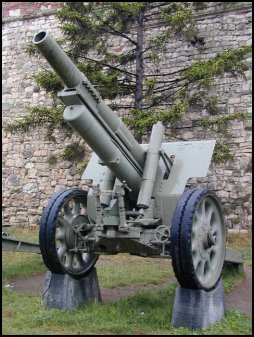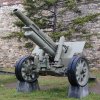|
|
 |
|
|
By Lasse Jensen
|
Last updated 08 June 2002
|
|
|
|
|
|
 149mm houfnice vzor 1937 (K4)
149mm houfnice vzor 1937 (K4)
|
|
|
|
General |
|
|
|
|
|
|
|
|
| Designer |
|
|

149mm houfnice vzor. 1937 K4
|
| Original
Manufacture |
|
Skoda, Czechoslovakia |
| Original
Manufacture name |
|
149mm
houfnice vzor
1937 (K4) |
|
|
|
| Is
this a license build gun? |
|
no |
|
|
|
| License
Manufacture |
|
~ |
| Customer
Aim |
|
Domestic
Military |
| Prototype
naming |
|
|
| Indented
country naming |
|
|
| Naming
variants |
|
Germany,
'15cm sFH 37(t)' |
| reversion
models |
|
|
| Licenses
build variants |
|
|
| Export
variants |
|
|
|
|
|
| Nature
of weapon |
|
Field
Howitzer |
| Introduction
date |
|
|
| First
action date |
|
|
| Production
time |
|
|
| Production
number |
|
|
| Crew |
|
|
|
|
|
|
|
Gun
dimension |
|
|
|
|
|
|
|
| Caliber,
bore |
|
149.1mm |
|
| Caliber,
length/bore |
|
|
| Muzzle
brake |
|
no |
| Recoil
system |
|
Yes,
unknown |
| Breech
mechanism |
|
|
| Barrel
length (all) |
|
3.6m |
| Barrel
length (ex breech) |
|
|
| Barrel
weight (all) |
|
|
| Weight
(firing position) |
|
5.200Kg |
| Weight
(traveling order) |
|
5.730Kg |
| Length
(firing position) |
|
|
| Length
(traveling order) |
|
|
| Width
(firing position) |
|
|
| Width
(traveling order) |
|
|
| Height
(firing position) |
|
|
| Height
(traveling order) |
|
|
| Ground
Clearance (towing) |
|
|
|
|
|
|
|
Gun
performers |
|
|
|
|
|
|
|
| Traverse
Right |
|
23° |
|
| Traverse
Left |
|
22° |
|
| Elevation |
|
+70° |
|
| Depression |
|
-5° |
|
| Ammunition
types |
|
43kg -HE |
|
| Maximum
Range |
|
15.750m -HE |
|
| Muzzle
velocity |
|
580m/s -HE |
|
| Rate
of Fire - 30s |
|
~ |
|
| Rate
of Fire - 4m |
|
~ |
|
| Rate
of Fire - 10m |
|
~ |
|
| Rate
of Fire - 1h, sustained |
|
~ |
|
|
|
|
|
|
Carriage |
|
|
|
|
|
|
|
| Name |
|
|
|
| Variants |
|
|
|
| Shield |
|
yes |
|
| Weight |
|
|
| Wheels
(if any) |
|
yes |
|
| Tyres
(if any) |
|
yes, unknown type |
|
|
|
|
|
|
Towing
vehicle |
|
|
|
|
|
|
|
| Primary
type |
|
|
|
| Trailer |
|
|
|
|
|
|
|
|
|
|
 History History
|
|
|
Despite the success of the 149mm K1, the Czech
army decided that the weapon did not meet its exact requirements and
funded further development to the stage where the K4 model met the
specification. The K4 had much in common with the K1, but had a shorter
barrel and the need for removing the barrel for separate horse traction
was no longer required as the Czech army was making great strides to be
fully mechanized. The K4 also had pneumatic wheels and some other
modifications to suit it for the tractor-towing role. With these changes,
the K4 was adopted by the Czech army as the 149mm hounfice vz37.
The Germans took the Skoda plant at Pilsen, finding on the production
lines the first of the full production vz37 howitzers. By that time only a
few models had been produced (some sources list as many a 1118!) and these were taken by the German army for
testing in Germany. The Germans discovered that the vz37 was a sound and
serviceable howitzer with a good range and firing a very useful 42kg
shell. The Germans decided to keep the vz37 in production at the Pilsen
plant for their own use and called it the 15-cm schwere Feldhaubitze 37(t)
that became a standard weapon of many divisions, forming part of the
divisional artillery equipment and even being used by some corps
batteries. It was used during the French campaign of May-June 1940 and
later during the invasion of the Soviet Union in 1941. Some were still in
service on the Eastern Front as late as 1944, but by then many had been
passed to the various Balkan forces under German control and operating in
what was Yugoslavia, the Slovak army being one such recipient.
German ammunition
production, for this gun, in thousands.
| 1939 |
1940 |
1941 |
1942 |
1943 |
1944 |
1945 |
| 40.5 |
92.5 |
17 |
69.8 |
245.1 |
191.2 |
? |
|
|
 More
Pictures More
Pictures
|
|
|
149mm houfnice vzor. 1937 K4 |
|
|
|
|
 |
|
|
|
|
| Unknown
location |
|
|
|
|
|
|
References:
Jeffrey Goldstein -which quote
these sources;
Chris Bishop (ed), Encyclopedia of Weapons of World War II, Barnes &
Noble Press, 1998.
Ian Hogg, Twentieth-Century Artillery, Amber Books, 2000.
Additional web resources.
Various web notes.
|
|
|
|
|
|
All pages
and Graphic on Builders Paradise are copyrighted (c) by LHJWORLD (TM) 2002
|
|

 149mm houfnice vzor 1937 (K4)
149mm houfnice vzor 1937 (K4)

